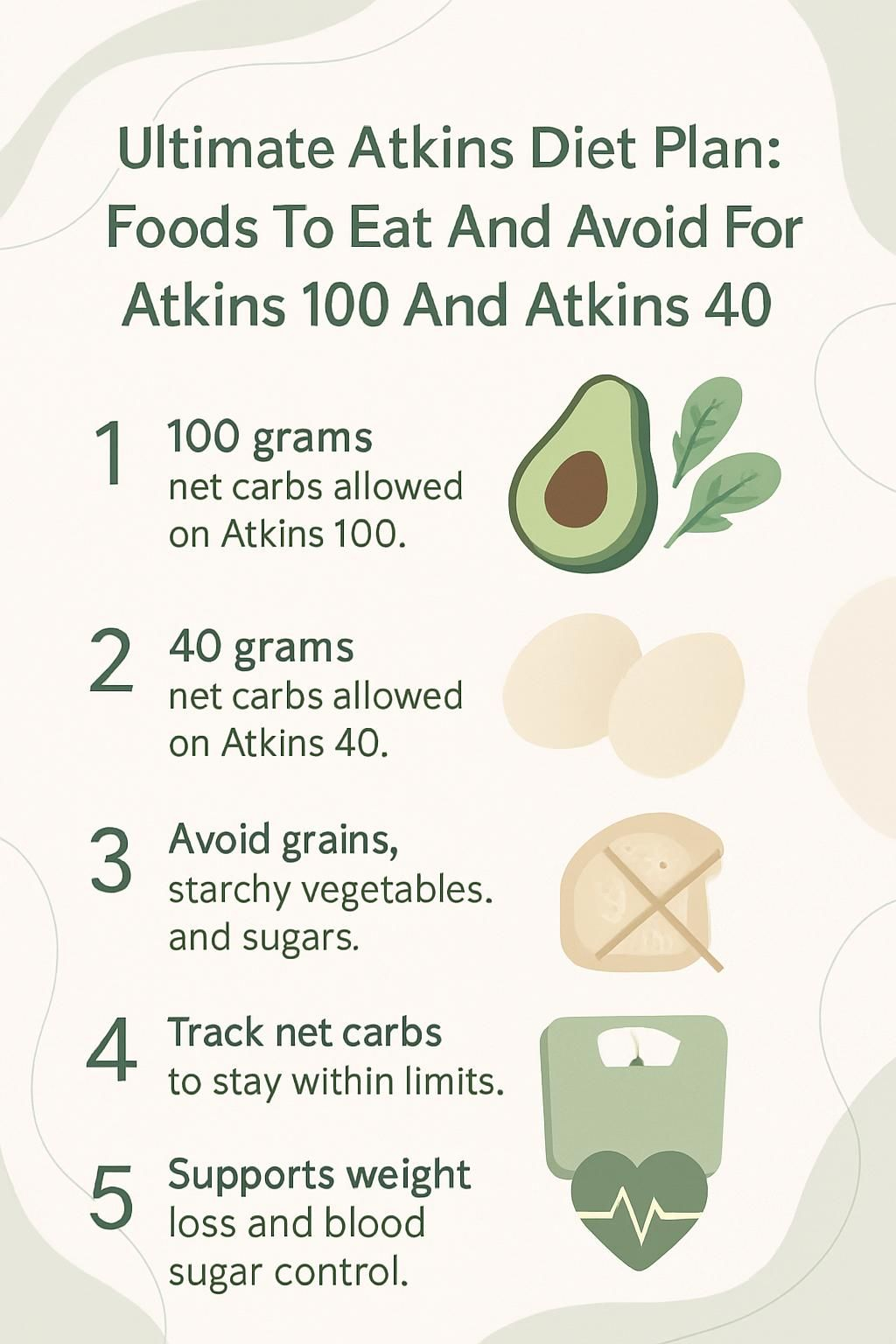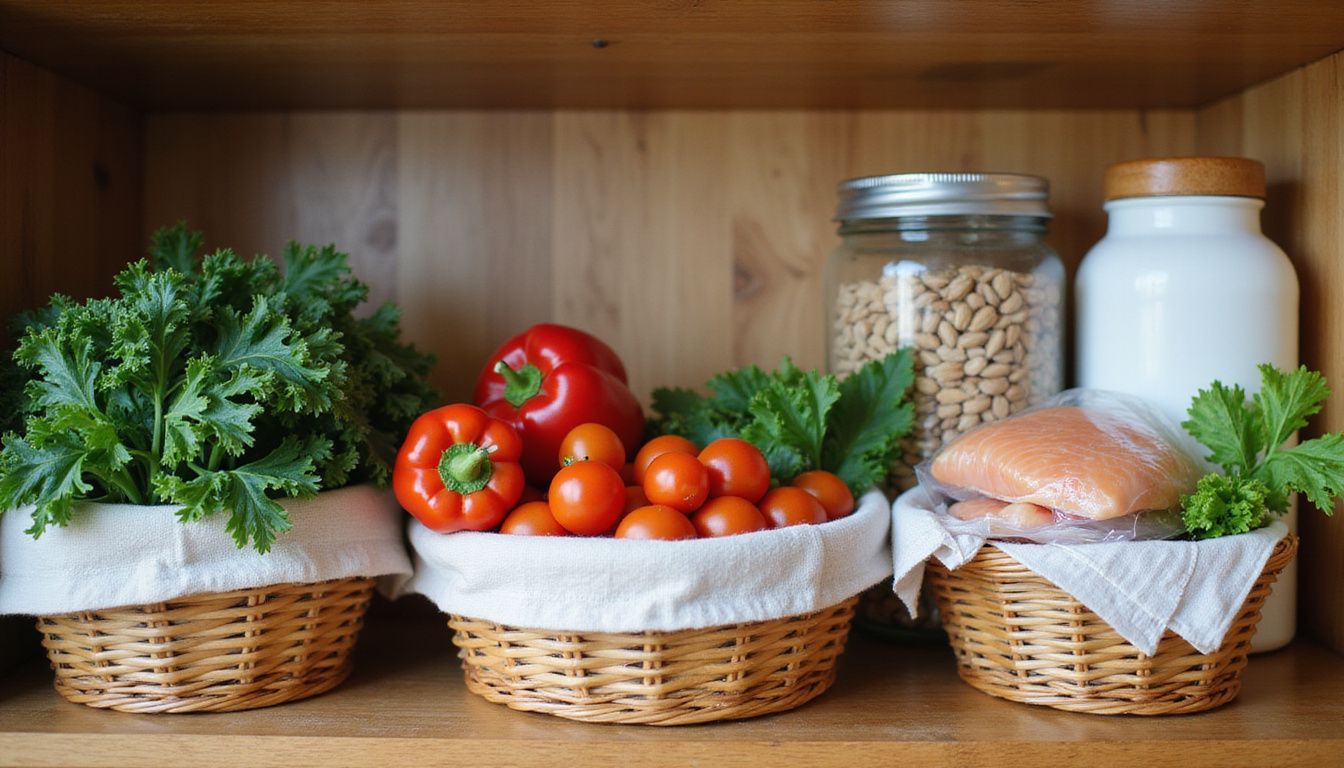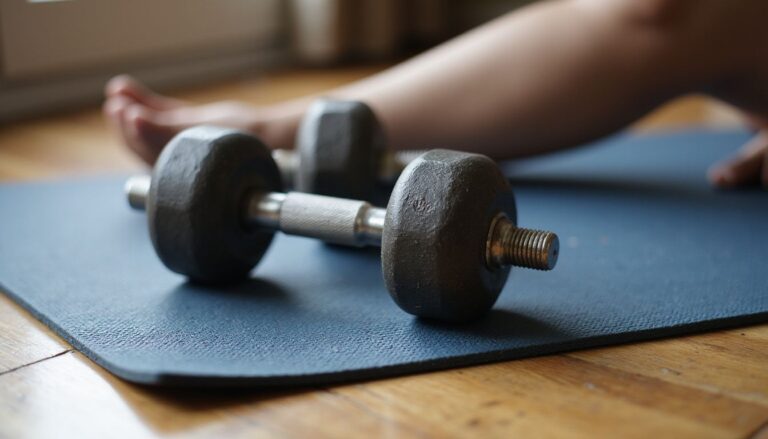Ultimate Atkins Diet Plan: Foods To Eat And Avoid For Atkins 100 And Atkins 40
Our Nutrition Assistant AI Suite will transform your body. You will lose fat, get toned, and build muscle. Gain confidence and optimal health.
You are not alone if you feel unsure about which foods help or slow progress on the Atkins diet. The plan has several versions, including Atkins 100 and Atkins 40, each with a daily net carb limit to support weight loss or maintenance.
This guide lists foods to eat and foods to avoid, then gives simple tips you can use right away. You will find meal ideas, tracking advice, and clear answers that make sticking to your plan easier.
Key Takeaways
- Atkins 100 allows up to 100 grams of net carbs per day for gradual weight loss or maintenance. Atkins 40 limits you to 40 grams daily for faster results.
- Good choices include meat, fish, eggs, full-fat dairy, non-starchy vegetables like greens and broccoli, healthy fats such as olive oil and avocado, and low-carb fruits like berries.
- Avoid high-carb grains, starchy vegetables like potatoes and corn, sugary drinks, sweets, most processed foods, and legumes in early phases.
- Track net carbs by subtracting fiber from total carbohydrates on the label. Staying within your daily limit is the core habit.
- Studies show low-carb plans similar to Atkins can support weight loss and improve blood sugar in people with type 2 diabetes compared with higher-carb diets.[1]

Overview of the Atkins Diet Approach

The Atkins Diet reduces carbohydrates to help your body burn fat and support weight loss. Different versions, such as Atkins 100 and Atkins 40, offer more or less flexibility based on your goals.
What is the Atkins Diet Method?
This method shifts your body from burning carbs to burning fat. You focus on protein and fat sources like meat, fish, eggs, avocado, butter, and full-fat dairy. Refined carbs like bread, pasta, potatoes, and sugar are limited, especially in early phases that can be as low as 20 grams of net carbs per day.
The classic plan uses four phases with different carb targets. You raise carbs slowly as you move along, which helps you find the highest carb level that still supports your goal. Many people report less afternoon fatigue and fewer cravings once they reduce sugar and refined grains.
Research comparing low-carb diets to low-fat diets often shows greater weight loss at 6 months on higher protein and lower carb approaches.[1] Higher protein and healthy fats also increase fullness, which can make the plan easier to follow.
Cutting added sugar made every meal taste cleaner for me.
How Does the Atkins Diet Work?
You start with a very low carb intake during Induction, often less than 20 grams per day. This encourages your body to use stored fat for energy. Net carbs means total carbs minus fiber. That number is what you track.
As you enter later phases, you add small amounts of carbs from foods like vegetables and berries. Atkins 100 caps net carbs at 100 grams daily. Atkins 40 caps them at 40 grams. Both plans focus on lower carb foods and steady blood sugar.
Many people find cravings drop when they base meals on protein, healthy fats, and non-starchy vegetables. Carb tracking quickly changes your choices at home and when eating out. Variety within approved foods keeps the plan sustainable.
Key Differences Between Atkins 100 and Atkins 40
Think of these two plans as lanes on the same highway, one wider and one narrower.
How Do Atkins 100 and Atkins 40 Differ?
| Feature | Atkins 100 | Atkins 40 |
|---|---|---|
| Daily Net Carb Limit | 100 grams | 40 grams |
| Main Purpose | Weight maintenance or gradual weight loss | Faster, steady weight loss with structure |
| Food Restrictions | Highly flexible, broader food choice | More structured, emphasizes vegetables, low-glycemic fruit, nuts, and some whole grains |
| Ideal For | People maintaining weight or preferring a slower pace | People who want moderate weight loss with clear guardrails |
| Carb Distribution | Spread net carbs across meals | Focus carbs on permitted food groups only |
| Vegetable Emphasis | Foundational vegetables encouraged | Vegetables form the base of meals |
| Personal Experience | Often easier at social events since you have more flexibility. | Great if you like plans with firm guidance. Many users, me included, see quicker early wins while staying satisfied. |
This side-by-side view highlights daily carb limits, structure, and flexibility. Match the plan to your appetite, pace, and lifestyle.
Who Should Follow Atkins 100?
Choose Atkins 100 if you want to maintain weight or prefer slower loss. It suits vegetarians and vegans who need more plant variety. It also fits people who need more carbohydrates during pregnancy or nursing. Spreading carbs throughout the day helps steady energy.
This flexible plan makes family meals and cultural cuisines easier. It is a practical option after reaching your goal weight on a stricter plan.
Who Should Follow Atkins 40?
Atkins 40 fits people who want moderate weight loss without going very low carb. It is helpful if you have less than 40 pounds to lose, or if Atkins 20 feels too strict. The plan centers on vegetables, nuts, seeds, and low-glycemic fruit.
The structure helps you stay consistent, and the variety keeps meals interesting. Many use Atkins 40 to transition from a high-carb routine to a controlled-carb lifestyle.
Best Foods to Eat on the Atkins Diet
You can enjoy a wide mix of foods on Atkins while keeping carbs under control.
What Protein Sources Are Recommended?
Protein keeps you full and supports muscle. Choose from animal or plant sources based on your needs.
- Meats like beef, pork, lamb, and chicken are high in protein with few carbs.
- Oily fish and seafood such as salmon, trout, sardines, and mackerel provide protein and omega-3 fats that support heart health.
- Eggs are a complete protein. Omega-3 or pasture-raised eggs add extra nutrients.
- Lacto-ovo vegetarians can lean on eggs and cheese as primary animal proteins.
- Tofu, tempeh, edamame, and other soy foods work well starting in Phase 2 and later.
- Bacon can fit if sodium is not a concern for you. Choose quality options.
- Aim for balanced portions of protein at each meal rather than all-you-can-eat servings.
- Pair protein with non-starchy vegetables to increase fiber and volume.
- Rotate protein types across the week to cover more nutrients.
Which Healthy Fats Should I Include?
Healthy fats provide steady energy and help you feel satisfied. They also make vegetables taste great.
- Use extra virgin olive oil or avocado oil for most cooking and dressings. Both are high in monounsaturated fats.
- Add avocado to salads or eggs. It supplies fiber, vitamins, and creamy texture.
- Coconut oil handles higher heat. Its medium-chain fats may support ketone production in very low-carb phases.
- Include full-fat dairy like butter, cheese, heavy cream, and plain full-fat yogurt. If you manage high cholesterol, discuss portions with your clinician.
- Choose a mix of nuts such as almonds, walnuts, and pecans. Watch portions to keep carbs and calories in check.
- Use more unsaturated fats and fewer highly processed fats to support heart health.
- For plant-forward eaters, build calories from oils, nuts, seeds, and nut butters.
What Vegetables Are Allowed?
Non-starchy vegetables are the backbone of Atkins. They add fiber, volume, and key vitamins with very few carbs.
- Leafy greens like spinach, kale, and lettuce are low in carbs and rich in vitamin K.
- Broccoli and cauliflower offer vitamin C and fiber with low net carbs.
- Asparagus, zucchini, and cucumbers add crunch, water, and minerals.
- Bell peppers work in small portions, about under 6 grams net carbs per half cup.
- Mushrooms add B vitamins and umami flavor with minimal carbs.
- Celery sticks are a simple, nearly carb-free snack.
- Green beans are lower in carbs than most legumes and fit well in later phases.
- Radishes and turnips make good stand-ins for potatoes in recipes.
- Brussels sprouts and other cruciferous vegetables bring antioxidants and fiber.
Fill at least half your plate with non-starchy vegetables. This strategy helps you meet carb targets and stay full.
Which Low-Carb Fruits Can I Eat?
Fruits vary widely in sugar. Start with the lowest carb options, then test your tolerance.
- Berries like strawberries, raspberries, blueberries, and blackberries are the best pick for lower sugar impact.
- Cantaloupe and honeydew can fit in Phase 2 or later in small half-cup servings.
- Cherries are moderate in carbs, so measure portions carefully.
- Tomatoes, a fruit botanically, are low in sugar and rich in vitamin C.
- Peaches can return in small amounts in Phase 3 or 4 if your goals allow.
- Avocados are very low in net carbs and provide healthy fat.
- Lemon and lime wedges add flavor to water and meals with minimal carbs.
- Portion control matters. Fruit can raise carbs quickly if you stop measuring.
- Choose fruits listed as approved in official Atkins resources as you move through phases.
Measuring berries helped me avoid overeating during summer. I enjoyed something sweet without stalling progress.[1]
What Dairy Products Fit the Atkins Diet?
Full-fat dairy adds flavor, protein, and calcium. Choose plain products without added sugar.
- Cheese such as cheddar, Swiss, and mozzarella has 0 to 2 grams net carbs per ounce.
- Butter is a zero-carb fat that works in cooking and sauces.
- Heavy cream adds richness with less than 1 gram of carbs per tablespoon.
- Plain full-fat Greek yogurt offers protein and probiotics, usually 4 to 7 grams net carbs per serving.
- Whole milk can fit in small portions, about 11 to 12 grams carbs per cup, best for maintenance.
- Cottage cheese is an option if it is full fat and unsweetened.
- Cream cheese is versatile and very low carb.
- Unsweetened kefir supplies probiotics. Watch portions on lower-carb days.
- Pair dairy with nuts, seeds, berries, or eggs to build complete meals.
Are Seeds and Low-Glycemic Snacks Good Choices?
Smart snacks help you control hunger between meals without blowing your carb budget.
- Almonds, walnuts, and macadamias provide healthy fats. Keep servings small to manage calories and carbs.
- Seeds like sunflower and pumpkin add fiber and minerals. They work well for plant-focused eaters.
- Low-glycemic snacks such as sliced peppers or leafy greens support steady blood sugar.
- Choose nuts or seeds instead of chips or pretzels to avoid refined starch.
- Higher fat snacks increase satiety, which can reduce overeating later.
- Pre-portioned nut packs make busy days easier while limiting excess intake.
- Track carbs from nuts and seeds. Portions matter even for low-carb foods.
- Vegetarians can rely on nuts and seeds to boost protein and texture.
- Mix different seeds and nuts during the week to cover more nutrients.
- Since Atkins limits grains, smarter snacking plays a big role in long-term success.
Foods to Avoid on the Atkins Diet
Skipping high-carb foods helps you stay within your daily net carb limit and speeds progress.
Which High-Carb Grains Should I Skip?
Refined grains can spike blood sugar and raise carb counts quickly. Even small portions can exceed your budget.
- White bread is made with refined flour that digests fast and raises blood sugar.
- White rice is stripped of fiber and nutrients, so carbs add up quickly.
- Regular pasta often has more than 40 grams of carbs per cooked cup.
- Cornflakes and sugared cereals are dense in carbs and sugar.
- Bagels pack large amounts of carbs in a single serving.
- Many crackers are refined and low in fiber, even whole wheat versions.
- Pretzels are mostly starch with little nutrition.
- Cakes, cookies, and muffins combine refined flour with added sugar.
- Couscous, made from semolina, has high carbs per serving.
Swapping bread and rice for roasted cauliflower or almond flour helped me cut cravings and keep energy steady.
What Sugary Foods Need to Be Eliminated?
Sugary foods work against your goals and make cravings worse. Many foods labeled low fat are high in added sugar.
- Sodas and soft drinks can contain more than 30 grams of sugar per can.
- Fruit juices pack concentrated sugar and lack fiber. A cup can exceed 20 grams of sugar.
- Desserts like cake, cookies, ice cream, and candy add empty calories and spike insulin.
- Sweetened breakfast foods, including flavored yogurt, granola bars, and pastries, often list sugar near the top of the ingredients.
- Use non-nutritive sweeteners sparingly, since they may keep cravings going for some people.
- Sugary cereals are off-plan for both Atkins 100 and Atkins 40.
- Low-fat snacks often replace fat with sugar and starch. Read labels closely.
- Many energy bars hide several teaspoons of added sugar in small servings.
- Sweetened plant milks can add unplanned carbs. Choose unsweetened versions.
- Dried fruit is sugar dense. Even small amounts can exceed daily carb limits in early phases.
Dropping soda for one week cut my sweet cravings and made the plan easier to follow.
Which Starchy Vegetables Are Not Allowed?
Starchy vegetables contain many carbs and can slow fat loss, especially early on.
- Potatoes of all types are high in carbs, around 37 grams per cup.
- Sweet potatoes have more than 20 grams of carbs per medium potato.
- Corn contains nearly 30 grams of carbs per cup.
- Parsnips and peas are higher carb choices and are best avoided.
- Winter squash like butternut and acorn run higher in carbs per serving.
- Yams are similar to sweet potatoes in carb content.
- Cassava, often used in gluten-free items, is very high in starch.
I saw better progress by skipping these vegetables and leaning on non-starchy options during early phases.
Why Avoid Legumes Like Beans and Lentils?
Legumes are nutritious, but they are high in net carbs and are not included during induction.
- Cooked lentils have about 36 grams of carbs per cup, which can exceed daily limits.
- Limiting legumes early can help stabilize blood sugar and support ketosis.
- Higher portions of legumes can prevent you from entering or maintaining ketosis.
- Canned beans sometimes contain added sugar or extra sodium. Read labels.
- Vegetarians who rely on legumes may need careful planning to keep carbs in range.
- Small portions can be tested later in the plan once carb tolerance improves.
- If you track cholesterol and lipids, discuss legume intake with your clinician.
These points explain why legumes usually return in later phases, and only in measured amounts.
What Processed Foods Should Be Avoided?
Many packaged foods contain hidden sugars and starches that derail progress. Whole foods make carb tracking simpler.
- Avoid low-fat or diet-labeled products that replace fat with sugar or starch.
- Skip baked goods like cake, cookies, donuts, pastries, and most crackers.
- Boxed breakfast cereals often exceed 20 grams of carbs per serving.
- Processed snacks such as pretzels, chips, and puffed snacks are mostly refined starch.
- Sweetened yogurt cups can contain as much sugar as dessert.
- Frozen entrees often include pasta, rice, or carb-heavy fillers.
- Candy bars and many protein bars hide added sugars despite high protein claims.
- Watch condiments like ketchup, barbecue sauce, and marinades. Two tablespoons can add several grams of net carbs.
- Canned soups often add potatoes, pasta, or beans and come with high sodium.
- Skip flavored waters and boxed juices that include added sugars. Choose water or unsweetened drinks.
Cooking simple meals from fresh ingredients helped me control cravings and keep energy stable through the day.
Tips for Planning Meals on the Atkins Diet
Good planning shrinks guesswork and keeps meals interesting on Atkins 100 and Atkins 40.
How Can I Manage Net Carbs Effectively?
Calculate net carbs by subtracting fiber from total carbs. Track this number for each food. Stay under 100 grams for Atkins 100 or 40 grams for Atkins 40.
Plan your meals in advance and spread carbs across the day. If you include fruit or grains, measure carefully, since these can raise carbs fast. During Atkins 20 induction, keep net carbs under 20 grams for a stronger early effect.
A simple journal with columns for food, total carbs, fiber, and net carbs keeps tracking clear. Increase carbs slowly once you reach a healthy weight to limit plateaus.
How Do I Ensure Variety in My Meals?
Use a three-week rotation to avoid boredom. Rotate proteins like chicken, fish, pork, beef, and tofu. Change your fats too. Dress one salad with olive oil, then cook with coconut oil another day.
Mix low-carb vegetables such as broccoli, spinach, zucchini, and cauliflower. Keep quick snacks on hand. One day have cheese cubes, the next try pumpkin seeds. Swap high-carb sides with low-carb stand-ins, like cauliflower mash instead of potatoes. Small changes keep meals interesting and on target.
As your carb tolerance rises in later phases, add new foods in measured amounts. This approach kept me engaged and steady on my weight loss path.
What Beverages Are Best, and Why Is Hydration Important?
Water is your best choice. It has zero carbs and supports digestion and energy. Sparkling water, herbal tea, coffee, and green tea can fit if unsweetened. If you use cream, stick to small amounts.
Alcohol should be limited. Dry wine is a better pick than beer or sweet cocktails. Adequate fluids help your kidneys and may reduce headaches and constipation during early low-carb days.
How Should I Monitor Portion Sizes?
Use a food scale or tracking app for accuracy, especially with nuts, dairy, fruit, and whole grains. Adjust portions to stay under your daily target.
Load up on non-starchy vegetables, which are low in carbs and high in volume. Be cautious with packaged low-carb snacks. Calories and hidden carbs can add up. As you reintroduce carb-rich foods later in the plan, reduce portion sizes to protect results.
Sample Meal Plan for Atkins 100
Atkins 100 offers more flexibility. Aim for balanced plates that combine protein, healthy fat, and non-starchy vegetables.
What Are Some Breakfast Ideas for Atkins 100?
- Scramble two eggs with spinach or kale, then add sliced avocado.
- Mix full-fat plain yogurt with one-third cup berries and a sprinkle of chia or flax.
- Make a vegetable omelet with mushrooms, peppers, and zucchini. Add shredded cheese.
- Stir half a cup of cooked oatmeal or quinoa with nuts and raspberries to fit your carb budget.
- Pair sliced cheese with a small apple or strawberries for a portable option.
- Spread almond butter on low-carb seed bread for a quick, filling toast.
- Combine cottage cheese with sunflower seeds and cucumber for a savory bowl.
Batch-prepped veggie omelets helped me stay focused during busy mornings.
What Can I Have for Lunch on Atkins 100?
- Grilled chicken or turkey breast as a lean protein base.
- Salmon or sardines for omega-3s and flavor variety.
- Half-plate salads with greens, peppers, and cucumbers dressed with olive oil.
- Top salads with almonds or chia seeds for crunch and healthy fats.
- Add a small serving of brown rice or bulgur if your carb budget allows.
- Use full-fat cheese or plain Greek yogurt as a side or topping.
- Include low-carb fruit, like berries or melon slices, in measured portions.
- Stir-fry mixed vegetables such as broccoli, zucchini, and tomatoes for fiber and color.
- Time higher-carb foods at lunch if that supports afternoon energy for you.
- Drink water or unsweetened tea to support hydration and focus.
Explore dinner options next to round out your day on Atkins 100.
What Are Dinner Options for Atkins 100?
- Choose grilled beef, pork, lamb, or dark meat chicken, about 4 to 6 ounces.
- Roast non-starchy vegetables like broccoli or asparagus with olive oil and herbs.
- Cook with butter or avocado oil to add flavor and satiety.
- Include a small portion of quinoa or brown rice if it fits your daily limit.
- Add a leafy salad with a full-fat, low-sugar dressing, such as ranch or blue cheese.
- Use two vegetable sides if you want more volume without extra carbs.
- Rotate proteins like baked fish, chicken thighs, or turkey cutlets for variety.
- Enjoy a small low-carb dessert, such as berries with whipped cream.
Oven-roasted broccoli with garlic plus a grilled steak became a favorite in my rotation.
What Snacks Are Suitable on Atkins 100?
- Hard-boiled eggs, about 6 grams of protein and under 1 gram of carbs each.
- Cheese slices or plain Greek yogurt for protein and fat.
- Almonds, walnuts, or sunflower seeds in quarter-cup portions.
- Raw vegetables like celery or cucumber with a low-carb dip.
- Berries in half-cup portions for under 10 grams net carbs.
- Portion-controlled whole-grain crackers if they fit your daily limit.
- Atkins-approved low-carb bars on busy days, after checking the label.
- Swap chips for nuts or crisp vegetables to reduce carbs.
- A small piece of cheese with mixed nuts kept me alert during afternoon study sessions.
Plan snacks that support your total carb budget so you stay on track.
Sample Meal Plan for Atkins 40
Atkins 40 gives clear guardrails with room for choice. Keep meals simple, colorful, and filling.
What Are Breakfast Options for Atkins 40?
- Scramble two eggs in butter or coconut oil. Add spinach and diced avocado.
- Make an omelet with peppers, mushrooms, and a small serving of shredded cheese.
- Pair unsweetened Greek yogurt with a few raspberries or blackberries.
- Prep hard-boiled eggs and serve with cucumber or cherry tomatoes.
- Build a cottage cheese bowl topped with nuts or seeds for steady energy.
- Fill avocado halves with a simple egg salad made with mayo and herbs.
- Brew coffee or tea without sugar. Add heavy cream if desired.
- Season with herbs and spices instead of sugary sauces.
- Avoid toast, oatmeal, pastries, most fruits, and higher-carb processed foods.
These options keep breakfast satisfying and under your daily carb target.
What Lunch Meals Work for Atkins 40?
- Grilled chicken or fish over leafy greens with olive oil or avocado oil dressing.
- Vegetable salads topped with shredded cheese and a handful of seeds.
- Turkey slices rolled with spinach, cheese, and avocado for a portable meal.
- Leftover salmon or beef paired with steamed broccoli.
- Unsweetened Greek yogurt with chopped nuts for fullness.
- Lettuce wraps filled with tuna salad made with mayo, celery, and cucumber.
- Chicken stir-fry with zucchini noodles for a noodle-like texture.
- Vegetable soup made from cauliflower, celery, and green beans.
- Small portions of nuts or seeds for crunch on the side.
Leftover grilled chicken tossed with fresh spinach kept me full for hours while staying low carb.
What Should I Eat for Dinner on Atkins 40?
- Choose baked or grilled fatty fish like salmon or lean meats like chicken breast.
- Add at least two cups of non-starchy vegetables such as broccoli, asparagus, or spinach.
- Cook with olive oil or real butter for flavor and satiety.
- Prepare a side salad with lettuce, cucumbers, and tomatoes plus a low-carb dressing.
- Skip starchy vegetables and grains to avoid blowing your carb budget.
- Use herbs and spices like garlic powder, basil, dill, and paprika for variety.
- Include one ounce of cheese or a small portion of nuts if desired.
- Drink water or herbal tea. Avoid sugary drinks.
What Snacks Are Recommended for Atkins 40?
- Hard-boiled eggs provide protein with almost no carbs.
- Cheese sticks offer protein and fat with minimal carbs.
- Raw vegetables like cucumber and celery deliver crunch and fiber.
- Almonds or macadamias, one ounce, for healthy fats. Keep portions small.
- Sunflower or pumpkin seeds, about two tablespoons, fit well.
- Very small servings of berries, such as strawberries or raspberries.
- Low-carb snack bars that list fewer than 5 grams net carbs per bar.
- Plain full-fat Greek yogurt or cottage cheese in half-cup portions.
- Turkey or chicken roll-ups for lean protein between meals.
- Olives add flavor and sodium, about 1 gram net carb per 10 olives.
Choose snacks that keep you satisfied and under 40 grams net carbs per day.
Health Benefits of Following the Atkins Diet
Many people notice quick wins, which motivates them to keep going.
How Does Atkins Support Weight Loss?
Reducing carbs encourages your body to use stored fat for fuel instead of sugar. Induction, often under 20 grams of carbs, is built for quick early changes. Studies show greater early weight loss on low-carb patterns compared with low-fat diets in some trials.[1]
People often report more energy and fewer cravings once they switch fuel sources. Atkins 40 tends to work faster than Atkins 100 because it sets a lower daily carb cap. Exercise, total calories, sleep, and consistency still matter for long-term results.
Can Atkins Improve Blood Sugar Levels?
Lower carb intake may help reduce blood sugar and insulin levels, especially in people with prediabetes or type 2 diabetes. Research suggests very low or low-carb diets can improve glycemic control and may support remission in some cases.[1]
My fasting glucose dropped below 100 mg/dL within two weeks on a controlled-carb plan. If you take diabetes medication, work with your healthcare provider to adjust treatment safely.
| Aspect | Low-Carb or Atkins Impact |
|---|---|
| Blood Sugar | Often decreases |
| Insulin Levels | May lower |
| Type 2 Diabetes | Possible improvement or remission |
| HDL and Triglycerides | Often improve |
Low-carb eating supports medical care but does not replace it. Always discuss changes with your clinician.
Does Atkins Boost Energy Levels?
Switching to fat as your primary fuel can stabilize energy. Many people report fewer afternoon crashes and better focus. Protein and healthy fats provide longer lasting fuel than refined carbs, which can reduce hunger between meals.
As you reintroduce carbs slowly, you can fine-tune your intake to avoid post-meal sleepiness and stay productive.
How Does Atkins Help Reduce Sugar Cravings?
Stable blood sugar helps prevent the highs and lows that trigger cravings. A higher protein intake and more healthy fats keep you satisfied longer, which can reduce the desire for sweets.
In early phases, you limit sugars and starches. You rely on vegetables and small portions of low-glycemic fruits such as berries to satisfy sweetness while staying within your carb budget.
Risks and Considerations When Using the Atkins Diet
Lowering carbs changes your usual eating pattern. Plan ahead and seek guidance if you have medical conditions, are pregnant, or are nursing.
What Nutrient Deficiencies Might Occur?
Limiting high-carb fruits, whole grains, and legumes can reduce your intake of vitamins, minerals, and fiber. Too little fiber may lead to constipation. Many people also fall short on magnesium and potassium when food variety narrows.
Focus on non-starchy vegetables, nuts, seeds, and quality proteins to cover more nutrients. Discuss supplements with a registered dietitian if needed.
What Are the Common Initial Side Effects?
Headaches, dizziness, fatigue, and weakness can occur during the first week as your body adapts. Some people notice constipation or muscle cramps. These often improve with enough water, electrolytes, and fiber from vegetables.
If symptoms persist or you have kidney issues or other conditions, seek medical advice before continuing. Strict rules can also lead to rigid eating for some people, so watch how you feel mentally and physically.
Why Is Medical Guidance Important?
Professional guidance helps protect your health and tailors the plan to your needs. Tracking net carbs can lower fiber intake if vegetables are limited. A clinician or dietitian can help you meet nutrition needs while staying within your carb target.
If you notice ongoing fatigue, lightheadedness, or digestive problems, ask your provider to review your plan and labs. This is especially important if you take medication for diabetes, blood pressure, or cholesterol.
Modifying the Atkins Diet for Vegetarians and Vegans
Plant-forward versions of Atkins are possible with careful planning. Focus on low-carb proteins and healthy fats.
What Plant-Based Proteins Work on Atkins?
- Tofu is versatile and low in net carbs per serving. Use it in stir-fries or salads.
- Tempeh adds texture and delivers protein with moderate carbs. Measure portions.
- Seitan, made from wheat gluten, provides high protein with few carbs if tolerated.
- Edamame offers protein and moderate carbs. Works best for Atkins 100.
- Hemp seeds supply protein and fat with very low net carbs. Sprinkle on vegetables.
- Pumpkin seeds are portable, protein rich, and low in net carbs in one ounce.
- Almonds and other nuts provide protein. Keep servings small to control carbs.
- Pea, rice, or soy protein powders help you hit protein goals with known carb counts.
Adding tempeh and hemp seeds helped me reach my protein target without raising my blood sugar.
What Low-Carb Vegetarian and Vegan Meals Can I Make?
- Tofu stir-fry with broccoli, peppers, and spinach for a satisfying, high-protein meal.
- Zucchini noodles tossed with olive oil, cherry tomatoes, basil, and hemp seeds.
- Cauliflower rice sautéed with mushrooms, onions, garlic, and chopped nuts.
- Chia seed pudding made with unsweetened almond milk for fiber and omega-3s.
- Grilled eggplant layered with a dairy-free cheese alternative for a hearty main dish.
- Lettuce wraps filled with tempeh, avocado, cucumber, herbs, and lime juice.
- Spaghetti squash boats with marinara and nutritional yeast for a comfort food feel.
- Roasted Brussels sprouts drizzled with tahini dressing and lemon.
- Stuffed bell peppers with riced cauliflower, tofu cubes, and herbs.
- Almond flour pancakes cooked in coconut oil for a grain-free breakfast.
Conclusion
Choosing Atkins 100 or Atkins 40 depends on your pace and lifestyle. Both plans center on lower carb eating, steady protein, healthy fats, and plenty of non-starchy vegetables. These choices can support weight loss, energy, and better blood sugar control.
Track net carbs, plan simple meals you enjoy, and check in with your healthcare provider, especially if you take medication or have medical concerns. With steady practice, you can build habits that last.
Evidence note [1]: Clinical studies and reviews of low-carbohydrate diets report greater early weight loss than low-fat diets in some trials, along with improved glycemic control in people with type 2 diabetes. Always seek personalized medical advice before changing your diet.
FAQs
1. What is the main difference between Atkins 100 and Atkins 40 in the Ultimate Atkins Diet Plan?
Atkins 100 allows up to 100 grams of net carbohydrates per day, while Atkins 40 limits intake to just 40 grams daily. This distinction affects which foods you can eat and how much flexibility you have with meal planning.
2. Which foods should I avoid on both Atkins 100 and Atkins 40?
Both plans recommend avoiding high-sugar items such as cakes, candies, sweetened drinks, white bread, pasta made from refined flour, and most processed snacks. These foods can raise blood sugar quickly and slow weight loss progress.
3. Can I include fruits or grains in my meals on these diet plans?
You may add small portions of low-glycemic fruits like berries more freely on Atkins 100 than on Atkins 40; however, higher-carb fruits such as bananas or grapes are not advised for either plan. Whole grains are limited but may be included in moderation under guidance for those following the less restrictive version.
4. How do protein sources fit into the Ultimate Atkins Diet Plan?
Lean meats like chicken breast or turkey slices provide essential nutrients without excess fat or carbs; fish offers healthy omega-3s that support heart health; eggs supply a complete protein source suitable for both versions of this eating approach. In my experience preparing weekly menus using these proteins helped me stay full longer while meeting nutritional goals set by each phase.
Summary: The key differences between these two approaches involve carbohydrate limits and food choices allowed within those boundaries. Both focus on reducing sugars and processed products while encouraging lean proteins plus select vegetables for balanced nutrition supported by research findings from clinical studies (Westman et al., Ann Intern Med.,2002).







